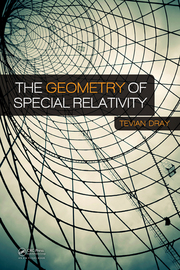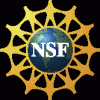The Geometry of Special Relativity
This short book treats the geometry of hyperbolas as the key to understanding special relativity. This approach can be summarized succinctly as the replacement of the ubiquitous $\gamma$ symbol of most standard treatments with the appropriate hyperbolic trigonometric functions. In most cases, this not only simplifies the appearance of the formulas, but emphasizes their geometric content in such a way as to make them almost obvious. Furthermore, many important relations, including but not limited to the famous relativistic addition formula for velocities, follow directly from the appropriate trigonometric addition formulas.
The Geometry of Special Relativity
Tevian Dray
A K Peters/CRC Press ©2012
ISBN: 978-1-4665-1047-0
(publisher website,
Amazon)
(Reviews: Editorial, Amazon, MAA)
Instructor Resources
The resources below have been developed for the course on Reference Frames at OSU, which includes two intensive weeks (14 hours of instruction) on special relativity.
Course overview
An overview of the course taught at OSU can be found here. This overview includes a detailed course outline, complete with links to lecture outlines and activity summaries, as well as links to recent course homepages.
Activities
A list of small group activities (SGA) and small whiteboard questions (SWBQ), organized by topic, can be found here. Each activity includes an instructor's guide for classroom use.
Wiki
A prepublication version of the book in wiki format is available here.
Feedback and Updates
Feedback can be sent to the author via email, and/or posted here using the Discussion tab above, or the similar tab associated with each section of the wiki version of the book. Updates and further discussion of selected topics will be posted here.
Errata
A list of known errors in the print version of the book will be maintained here. (Typos will be fixed in the wiki version of the book, which however does not contain all of the edits in the printed version.)

